Pharmaceutical Water filtration Methods:
In pharmaceutical industries, there are different types of methods used to filter the water some types of Filtration MF, UF, NF, & RO Filters are used to remove or reduce particulate matter which includes suspended particles, parasites, viruses, bacteria, algae, fungi, undesirable chemical and biological contaminants, and turbidity. In pharmaceuticals, there are many types of filtrations generally used for water purification.
In conventional methods we used the following methods for filtration:
- Sedimentation Filters.
- Multi Grade Filters (MGF).
- Activated Carbon Filter (ACF).
- Bag Filters.
- Softener with media.
- Mix-bed with (anionic cationic media).
In modern technology following filtrations are used for the generation of Purified Water.
- Micro Filtration (MF)
- Ultra-Filtration (UF)
- Nano Filtration (NF)
- Reverse osmosis Filtration (RO)
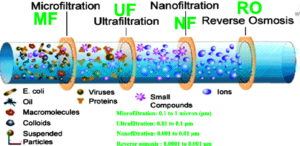
Filtration has the following sizes range:
- Microfiltration: 0.1 to 1 micron (μm)
- Ultrafiltration: 0.01 to 0.1 μm
- Nanofiltration: 0.001 to 0.01 μm
- Reverse osmosis (hyperfiltration): 0.0001 to 0.001 μm
Micro Filtration (MF):
Microfiltration is the process of physical removal of suspended solids from water, typically via a membrane. Microfiltration uses physical filtration to remove particles 0.1 to 10-micron in size, including bacteria, but it does not remove dissolved contaminants.
Microfiltration (MF) is the system in which membranes are developed to remove microbial contamination, protein fractionation, and pre-treatment to other membrane processes.
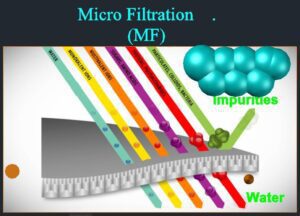
Micro filters are configured as spiral-wound and flat sheets. Microfiltration membranes and membrane systems can be efficiently tailored to meet particular application needs.
MF worked on a low-pressure separation process, using an open-pore membrane structure. These membranes are made of polymer as well as inorganic materials (SS and Ceramic).
Water microfiltration is typically accomplished through crossflow separation, which involves introducing a feed stream into the membrane under pressure and passing it over the membrane surface in a controlled flow path. Permeate refers to the portion of the feed stream that passes through the membrane.
Water microfilter work on the Crossflow separation, which entails putting a feed stream into the membrane under pressure and passing it across the membrane surface in a controlled flow path, this is the conventional method for doing water microfiltration.
The fraction of the feed stream that traverses the membrane is referred to as permeate.
The merits and demerits of the Micro filtrations:
| Merits | Demerits |
| MF reduces the chemical dose requirements. | MF is sensitive to oxidizing agents |
| MF reduces the fine films before the RO.
That will increase the life of the RO membrane. |
Microfilter membranes may be damaged by hard and sharp particles > 0.1 mm, therefore requiring more open pore pre-filtration. |
| Low operating pressure of water required.
Eliminate the cartage filter cost. Less RO system downtime. MF is relatively inexpensive. |
Micro filters have Sensitivity to oxidizing chemicals (such as high concentrations of peroxides and nitric, sulfuric persulfates) during water filtration. |
| Low energy consumption in semi-inactive units compared to nanofiltration or reverse osmosis during the filtration of water. | Micro filters’ diaphragm will fail if the diaphragm is flushed again with a pressure higher than 1 bar. |
| Virtually no manual operations are required during the filtration process. | |
| It does not require energy-intensive phase transitions such as the evaporation technique. |
Ultrafiltration (UF)
Ultrafiltration is also the filtration process to filter water and remove impurities from the water. Ultra-filters have a size of 0.01 μm to 0.1 μm.
Ultrafiltration is used to remove particles, some protozoa, viruses, and bacteria from the flow of water. The water which passed through the ultrafiltration membrane is called permeate water.
Ultra-filtration is an excellent way to remove pyrogen contaminations from water.
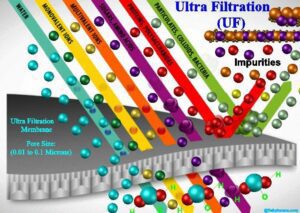
UF membrane can be made, both hydrophobic and hydrophilic polymer.
Ultra-filter membrane has a better MWCO i.e., Molecular weight cut-off value than the microfilter membrane this falls under (300 to 500000 Dalton). UF membranes are made in flat sheets as well as spiral wound types.
Advantages and Disadvantages of Ultrafiltration:
| Advantages | Disadvantages |
| UF has the ability to reject a wide range of contamination ranging from suspended organics, salts, silt pathogens,s and viruses. | UF alone cannot separate out certain chemical components.
Also, it has a polydisperse pore size. so, distribution may cause irreversible fouling, which causes challenges in controlling the porosity and pore size. |
| UF reduces continuous chloride addition or intermittent dose. | UF has a critical module design i.e., hollow fibers. Flat sheets, tubular membrane, etc. |
Ultrafiltration membranes are more open than nanofiltration and reverse osmosis RO, but more closed than microfiltration membranes.
The low pressure used by the membranes means cheaper operating expenses. Additionally, they contain a backwashing mechanism that extends their lifespan and is particularly efficient as a pre-treatment for reverse osmosis RO plants.
Nanofiltration:
Nanofiltration has the same process i.e., removals of the contamination from the water including organic molecules, viruses, organic matter, and different salts.
Nanofiltration membranes are able to separate divalent ions and monovalent cations.
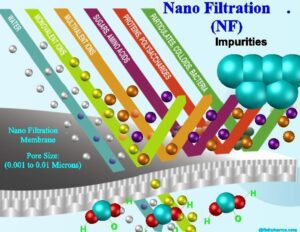
Nanofiltration is a pressure-driven membrane and has a separation process which often used to soften water.
In nanofiltration waters with low total dissolved solids, filtering utilizing a nano-porous membrane is known as nanofiltration. In addition to disinfecting, by retaining organic materials, the goal is to remove polyvalent ions.
Nanofiltration’s membrane has a range of pore size (0.001 to 0.01 μm) / 1nm to 10nm. And have MWCO i.e., Molecular weight cut off from 1000 to 200 Dalton.
This filtration falls between UF and RO:
Ultrafiltration⇒⇒⇒⇒Nanofiltration’s ⇒⇒⇒Reverse Osmosis Filtration
Advantages and Disadvantages of Nanofiltration:
| Advantages | Disadvantages |
| The ability of high retention of multivalent ions and salts. | NF membrane has scales because of the smaller pore size. Also, it has allowed monovalent ions to pass through. |
| Has high retention of low molecular weight organics materials. | Chemical resistance and limited life of the membrane. |
| Reduce scale in the RO membrane by removing hardness. | This is slightly expensive. |
Reverse Osmosis Filtration:
Reverse osmosis is a filtration process in which the RO systems remove impurities or contamination from softened water, like removing organic matter, and separate specific contaminants from water. RO works on the principle in which, the water flows through a semi-permeable membrane by exerting a pushing force greater than the osmotic pressure in the opposite direction of the osmosis process.
In Pharmaceuticals the process of refining antibiotics and concentration of hormones from the water. So the RO filter membrane has a pore size of around 0.0001 microns to 0.001 microns. And have MWCO i.e., Molecular weight cut off from 100 to 500 Dalton. Ro system also controls or reduces the conductivity of the water.
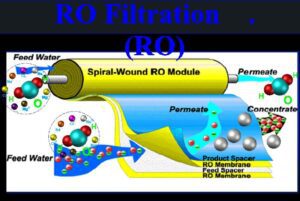
Once the pharma-grade water is passed through a reverse osmosis membrane, it becomes pure water. The reverse osmosis membrane is able to remove viruses, organic molecules, and even most minerals from water.
The water passed through the filter is also desalinated, as reverse osmosis also removes monovalent ions within the water. RO membranes are also chemically and hot water suitable.
RO Membrane element is made in spiral form by coiling membranes and they are usually 40 or 60 inches long, and the most common diameters are 4 or 8 inches.
A reverse osmosis system requires a pre-treatment setup like feed pumping equipment, pressurized tanks (membrane holders or housings) that contain the membranes, chemical dosing equipment, etc.
After filtration water should be tested by Quality Control and Microbiology Lab with their sampling procedure.
FAQ:
Is nanofiltration better than ultrafiltration?
Answer: Yes in terms of purity nano filtration give more pure water than ultrafiltration.
What is the difference between RO and UF membrane?
Answer: RO membrane having less pore size of around 0.0001 microns to 0.001 microns with 100 to 500 Dalton MWCO Value. but UF membranes have a pore size of 0.01 μm to 0.1 μm with MWCO of 300 to 500000 Dalton).
What is Ultra Filtration?
Answer: Ultrafiltration is a low-pressure technique that concentrates and separates suspended particles, colloids, and high molecular weight compounds from water at low pressure. UF has Tubular filter membranes.
What is ultrafiltration process?
Answer: The water flows or feeds in the UF Membrane, then the Water and solutes with low molecular weight pass through the barrier, whereas suspended solids and solutes with large molecular weight are trapped.UF is perfect for removing colloids, proteins, bacteria, pyrogens, proteins, and macromolecules larger than the membrane pore size from water when strategically integrated with other purification technologies in a full water system.
Where is ultrafiltration used?
Answer: UF used in the retreatment or before the RO. This will increase the life of the RO membrane and get better pure water.
What is a nano filtration system?
Answer: The waters with low total dissolved solids, filtering utilizing a nanoporous membrane is known as nanofiltration. In addition to sanitizing it by keeping organic stuff, the goal is to eliminate polyvalent ions.
What does nano filtration remove?
Answer: Nanofiltration removes suspended particles, parasites, viruses, bacteria, algae, fungi, and undesirable chemical and biological contaminants from the water.
Is RO water healthy to drink?
Answer: It depends on the TDS of the water provided by the RO membrane if its TDS is below 50 PPM then it’s not healthy for drinking. Also, the human body needs many minerals which are available in 100 ppm TDS water, and the RO membrane removes these minerals too which may cause many deficiencies in the human body.
Is RO harmful for health?
Answer: Yes in the case of low TDS below 50 ppm this causes a deficiency of minerals in the human body.
What filters are used in RO?
Answer: Reverse Osmosis system has a RO membrane of different shapes and different pore sizes as per the utilization of water or purity of the water we required.
For more information on water system-related setup, please write us at: admin@flairpharma.com
